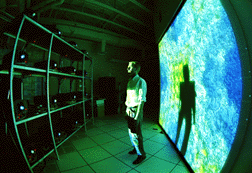Data rendered into art in seconds
New standard set for scientific visualizations
|

Max Headroom? No, even better — it’s Sandia’s David Logsted backstage, checking alignment of 16 digitized projectors that create an image on a 20-million-pixel screen with a clarity that old Max would only look on with envy. (Photo by Randy Montoya)
Download 300dpi JPEG image, ‘Visback.jpg’ 1.5MB (Media are welcome to download/publish this image with related news stories.)
|
ALBUQUERQUE, N.M. — A 10-foot-high, 13-foot-wide screen that makes high-definition television look as grainy as an old TV in a cheap motel has been unveiled by Sandia National Laboratories.
The facility’s digitized images, created of 20 million pixels, approach the visual acuity of the eye itself. “The eyeball is the limiting factor, not the screen,” says manager and program leader Philip Heermann. “From ten feet away, the image is as good as your eyes are able to see.”
The new screen is not only the clearest but also, says Heermann, “to my knowledge the fastest in the world in rendering complex scientific data sets.”
Each image, though representing scientific data, resembles a work by an old Dutch master who has met Jackson Pollock. The swirling images are as crowded yet detailed as if every ear of corn on a 100-acre farm were caught in a single image by a camera at 21,000 feet.
The images are expected to allow scientists a better view of complicated systems. Sandia’s immediate needs are to improve understanding of complex situations like crashes and fires, but the facility is also valuable for microsystems, nanotechnology and biological explorations. Says Heermann, “It does not make sense to view a detailed 20- or 100-million-cell simulation on a standard one-million-pixel display.” Data presented as columns of numbers would be a numbing amount of information for the brain to comprehend.
Faster than Hollywood
Clusters of computers, or “render farms,” used for many years in the movie industry, may take a half-hour or more to render a frame — the equivalent of the Sandia screen — but they cannot handle the data set sizes or the interactive rates of the Sandia cluster, which renders huge data sets in seconds.
The Sandia images are created through massively parallel imaging, which could be thought of as the kid brother of massively parallel computing — a method of orchestrating the individual outputs of many desktop computers to produce a combined output faster than a very complex, single supercomputer. In this case, the image is not created from a single graphics card but instead through the orchestrated outputs of 64 computers splitting data into 16 screens arranged as a 4 by 4 set.

War Room of the Enterprise? That’s not Kirk and Spock looking at a wormhole, but Sandia’s Ken Moreland, left, and Brian Wylie examining a complicated data set displayed with a clarity unmatched by the HDTV images on either side. (Photo by Randy Montoya)
Download 300dpi JPEG image, ‘VisLab.jpg’, 1.3MB (Media are welcome to download/publish this image with related news stories.)
|
|
Other, smaller render-clusters exist at Princeton, Stanford, and Lawrence Livermore National Laboratory. These programs, as well as another to be operable this winter at the University of Texas at Austin, are all funded by the Department of Energy’s Accelerated Strategic Computing Initiative (ASCI).
By January, Heermann expects the Sandia team to reach the project’s second phase goal of 64 million pixels — a major milestone of the ASCI VIEWS (Visual Interactive Environment for Weapons Simulation) program, which funds this work as well. “Sandia is the lab charged with responsibility for this milestone, and we will meet it,” he says.
Depending on budget and the availability of technology, 16 additional projectors with even higher resolution (1600 by 1200 pixel resolution) will eventually be installed along with another array of 16 more 1280 by 1024 projectors for a total of three projector arrays with an overall display resolution of 69 megapixels. This capability will support the VIEWS FY02 Milestone — Scalable Rendering System to drive a 64-megapixel display. This is a technically aggressive goal, but the result for users will be very large, very bright, and very detailed computer display images.
Sandia is a multiprogram laboratory operated by Sandia Corporation, a Lockheed Martin Company, for the United States Department of Energy under contract DE-AC04-94AL85000. With main facilities in Albuquerque, N.M., and Livermore, Calif., Sandia has major research and development responsibilities in national security, energy and environmental technologies, and economic competitiveness.
Media contact:
Neal Singer, nsinger@sandia.gov, (505) 845-7078
Sandia technical contact:
Phil Heermann, pdheerm@sandia.gov , (505) 844-1527
|
